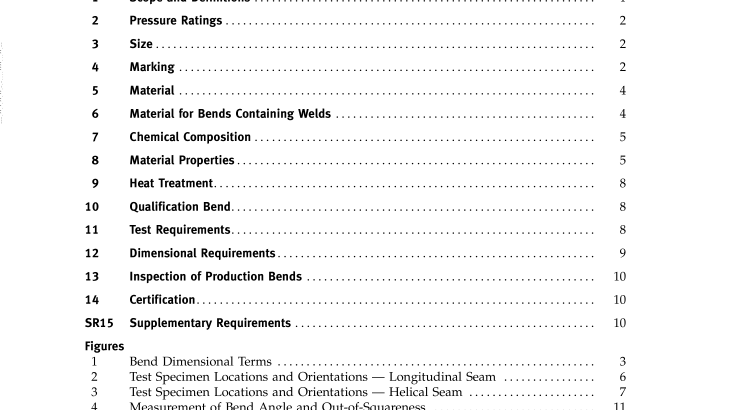ASME B16.49-2007 pdf free download.Factory-Made, Wrought Steel, Buttwelding Induction Bends for Transportation and Distribution Systems
6 MATERIAL FOR BENDS CONTAINING WELDS 6.1 Longitudinal Weld Seams 6.1.1 Seam welds in pipe made to an API, ASTM, or CSA specification must meet welding and nonde- structive examination (NDE) requirements of that speci- fication.
6.1.2 Other pipe or cylinders, not manufactured to the above specifications, shall be made by welders, welding operators, and welding procedures qualified under the provisions of Section IX of the ASME Boiler and Pressure Vessel Code (BPVC). Before bending, 100% of each weld seam shall be radiographed in accordance with ASME Section VIII, Division 1, para. UW-51, and shall meet the acceptance criteria specified therein. In place of radiographic examination, welds may be ultrasonically examined in accordance with Appendix 12 of ASME Section VIII, Division 1.
6.1.3 The longitudinal weld seam should be located on the neutral axis ( p 0 deg or 180 deg in Fig. 1). When this is not possible, the weld seam shall be located not more than 15 deg from the neutral axis. Helically welded pipe is an exception to this weld loca- tion requirement.
6.2 Girth Welds Bending through a girth weld shall not be allowed unless agreed upon between the purchaser and manu- facturer. 7 CHEMICAL COMPOSITION The chemical composition of each heat 1 of material furnished to this Standard, as determined by a product analysis, shall be in accordance with Table 2. Each ele- ment specified in Table 2 shall be tested for and reported on the material test report required in section 14. The carbon equivalent (CE) shall not exceed 0.45% as com- puted by eq. (2):
8 MATERIAL PROPERTIES The properties of the bend, as determined for each lot, 2 shall be in accordance with the ordered grade listed in Table 1.
8.1 Tensile Properties The tensile properties shall be determined for the qualification bend in accordance with ASTM A 370. The yield-to-tensile ratio shall not exceed 0.90, except for Grade P483 (X483) and higher, for which the ratio shall not exceed 0.93. When the strength of the bend does not meet the ordered strength, the manufacturer may provide, with purchaser approval, bends of comparable strength to the design pipe. The thickness of the bend shall be at least equal to the specified design pipe thick- ness multiplied by the ratio of the specified minimum yield strength of the pipe and the minimum tested yield strength of the bend. For bends from welded pipe of NPS 8 (DN 200) or larger, a transverse weld tensile test in the final heat-treat condition shall be conducted to determine the ultimate tensile strength. See para. 11.1.1 for number, location, and orientation of test samples required.
8.2 Fracture
Toughness Properties Notch toughness properties of the bend material in the final heat-treated condition shall be determined on the qualification bend in all locations specified in Fig. 2 or3 bya setofthree transverse,full-size, CharpyV-notch specimens, with or without tapering 3 the ends, in accor- dance with ASTM A 370. When the material wall thick- ness does not permit machining full-size (10 mm ? 10 mm) specimens, the largest size possible of either 2 ⁄ 3 size or 1 ⁄ 2 size shall be substituted. All dimensions other than thickness are the same for full-size specimens. Specimens shall be taken with the axis transverse to the longitudinal axis of the bend. If material wall thickness does not allow at least a 1 ⁄ 2 -size Charpy specimen, no impact testing is required. Specimens shall be tested at −10°C (+14°F) or lower, unless otherwise specified by the purchaser (see para. SR15.4), and shall achieve an average shear area for all specimens of at least 50%, with no one specimen less than 40%. In addition, all specimens shall exhibit a minimum absorbed energy value of 27 J (20 ft-lbf) for Grade P386 (X386) and lower, and a minimum of 54 J (40 ft-lbf) for grades higher than P386 (X386). Weld metal shall meet an absorbed energy value of 27 J (20 ft-lbf) minimum for all grades. If using reduced specimens, the impact values may be reduced in accordance with the correction ratios in ASTM A 370. See para. 11.1.2 for location of testing samples required.
8.3 Hardness
Testing Hardness tests shall be performed in accordance with ASTM A 370 on the bend as required in para. 11.1.4. To verify uniformity in the bending process, all production bends shall be tested for hardness in the same locations as the qualification bend. The corresponding areas shall have average hardness readings in the same quadrant around the circumference withinthe same average range as the qualification bend, with no average equating to a tensile strength less than that required in Table 3 for the material grade marked on the bend. Use an average of at least three readings for each location tested. The type of portable hardness tester used on production bends shall be the same as used on the qualification bend. All testing shall be conducted in the final heat- treated condition. No hardness measurement shall exceed the maximum specified in Table 1.ASME B16.49 pdf download.ASME B16.49-2007 pdf free download
